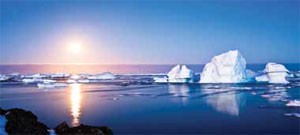Oh! Zone

By Terri Sota
The Southern Hemisphere may no longer have the only pole with a hole on top. A recently published paper makes the case for "an Arctic ozone cavity" of significant, but lesser magnitude than the scene-stealing void over Antarctica. More than 80 percent of the ozone — at altitudes of 11 to 12 miles — disappeared between January and March, leaving populations in Russia, Greenland and Norway susceptible to harmful, ultraviolet (UV) rays. Although some disagree whether the depletion of the ozone up north constitutes a true "hole" (a threshold for ozone loss has never been established), all concur that the hit to the Arctic's stratosphere is unprecedented.
What was unique about the winter of 2010-2011? According to NASA's Gloria Manney, lead author of the climate study, daily temperatures were no lower than in high-ozone winters. The difference was that "the extreme cold lasted more than a month longer than any previously studied Arctic winter [and produced] ozone-destroying forms of chlorine for a much longer time." The cause of the prolonged cold was an unusually strong polar vortex (a frigid, cyclonic air mass) that encircled Santa's home, blanketing approximately 6 million square miles. The atmosphere over the North Pole was locked up and prevented from mixing with warmer air from the mid-latitudes.
Antarctica's hole is an annual occurrence. Winter temperatures of -108 degrees Fahrenheit (-78 degrees Celsius) create stratospheric clouds that accumulate inactive chemical pollutants, which react to form active, ozone killers. This process continues until the polar vortex breaks up and temperatures rise. Unlike the Arctic, which regularly receives new ozone, Antarctica experiences ozone levels that drop to zero year after year.
Global warming may promote continued long-term cold in the Arctic. At stake is the ecosystem; more UV radiation will impede the growth of some ocean algae that anchor the polar food chain. Lower-latitude cities, including New York, San Francisco and Rome, will also be impacted, as ozone-poor air increases in mass and travels south. Without ozone protection, more of the planet will be exposed to high-frequency UV radiation, which can damage DNA and cause skin cancer and cataracts. And, according to researchers, only a slight drop in Arctic winter stratospheric temperatures is necessary for all of this to occur. Despite successful global initiatives to reduce pollutants, climate change is configuring a hole new world...at the North Pole.
Classroom Discussion
- Discuss the 1987 Montreal Protocol (initiated a global phase-out of chlorofluorocarbons (CFCs) and why CFCs continue to be an issue in the atmosphere, but not on Earth.
- Talk about the advantages and disadvantages of using sunscreen (i.e., vitamin D deficiency).